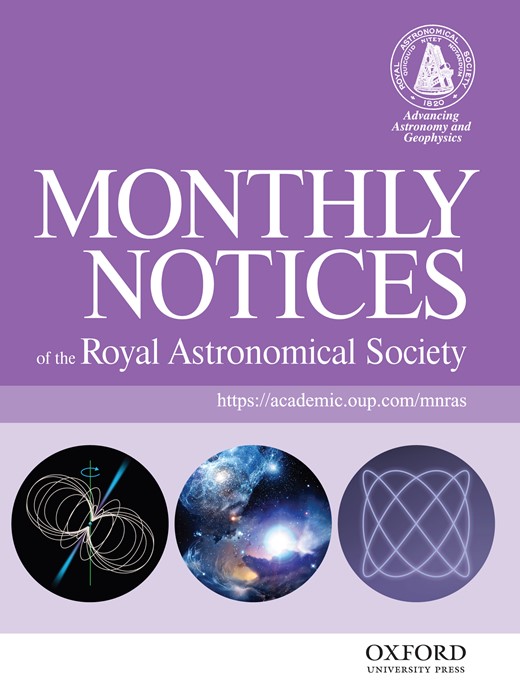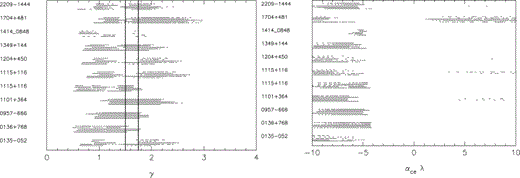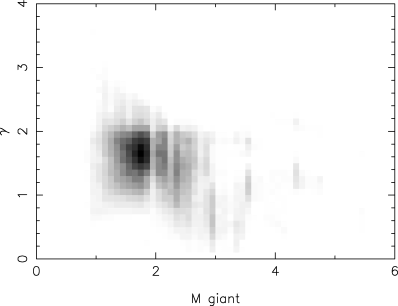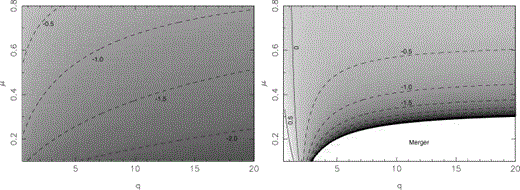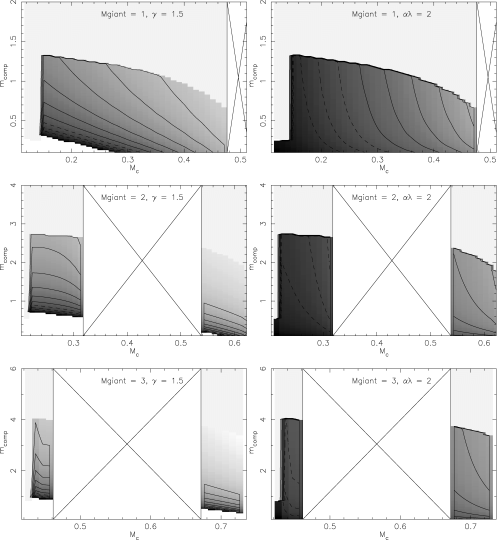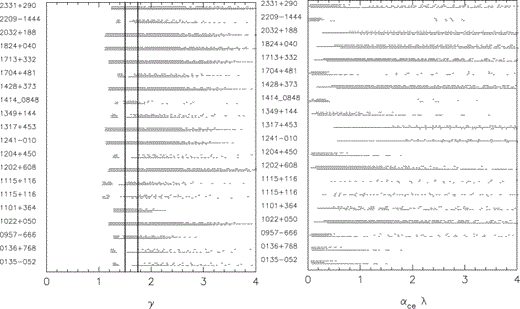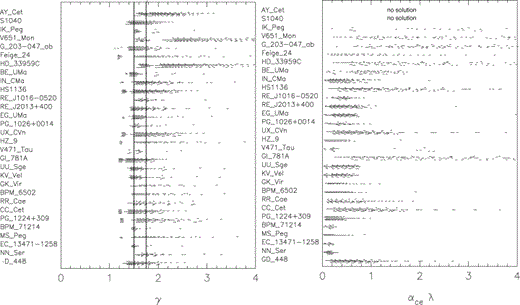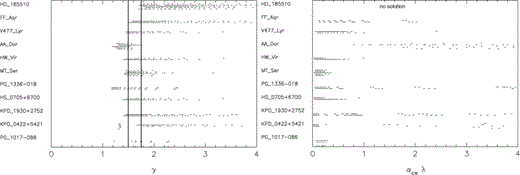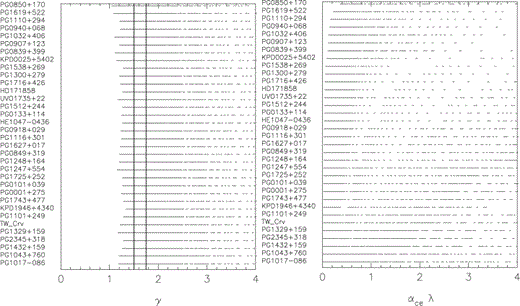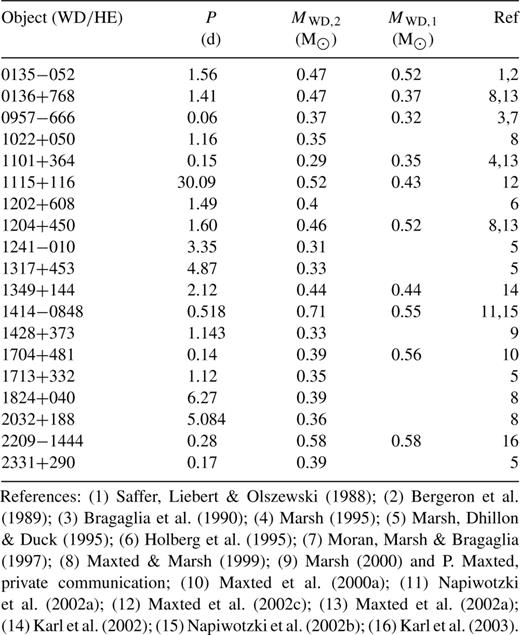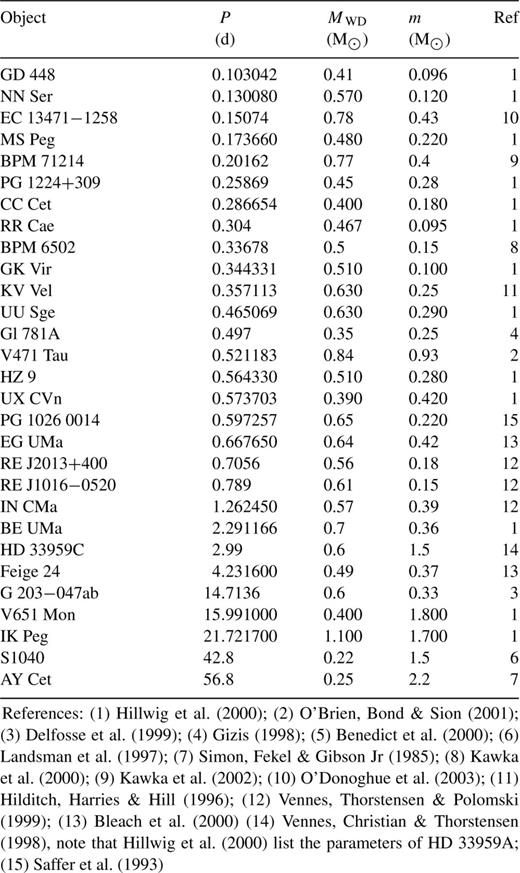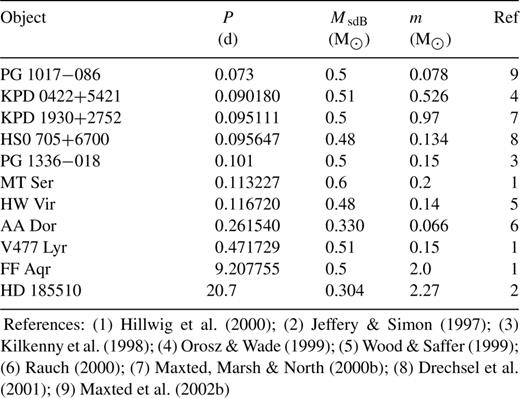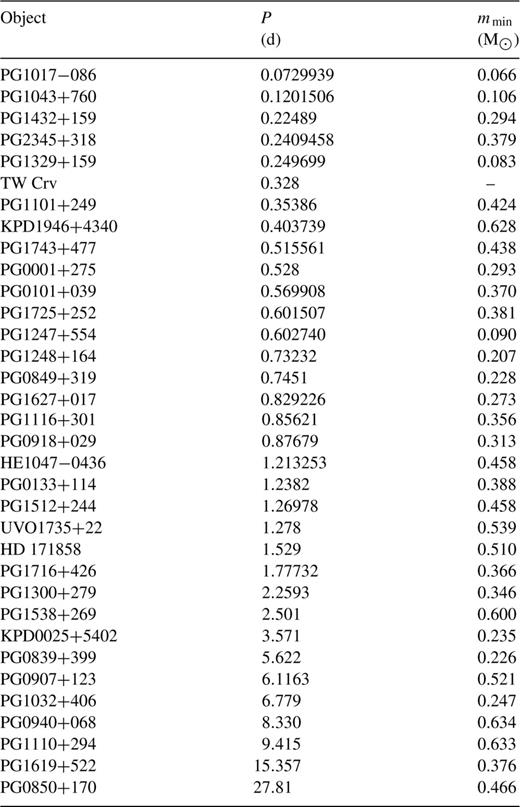-
PDF
- Split View
-
Views
-
Cite
Cite
G. Nelemans, C. A. Tout, Reconstructing the evolution of white dwarf binaries: further evidence for an alternative algorithm for the outcome of the common-envelope phase in close binaries, Monthly Notices of the Royal Astronomical Society, Volume 356, Issue 2, January 2005, Pages 753–764, https://doi.org/10.1111/j.1365-2966.2004.08496.x
Close - Share Icon Share
Abstract
We determine the possible masses and radii of the progenitors of white dwarfs in binaries from fits to detailed stellar evolution models and use these to reconstruct the mass-transfer phase in which the white dwarf was formed. We confirm the earlier finding that in the first phase of mass transfer in the binary evolution leading to a close pair of white dwarfs, the standard common-envelope formalism (the α-formalism) equating the energy balance in the system (implicitly assuming angular momentum conservation) does not work. An algorithm equating the angular momentum balance (implicitly assuming energy conservation) can explain the observations. This conclusion is now based on 10 observed systems rather than three. With the latter algorithm (the γ-algorithm) the separation does not change much for approximately equal-mass binaries. Assuming constant efficiency in the standard α-formalism and a constant value of γ, we investigate the effect of both methods on the change in separation in general and conclude that when there is observational evidence for strong shrinkage of the orbit, the γ-algorithm also leads to this. We then extend our analysis to all close binaries with at least one white dwarf component and reconstruct the mass-transfer phases that lead to these binaries. In this way we find all possible values of the efficiency of the standard α-formalism and of γ that can explain the observed binaries for different progenitor and companion masses. We find that all observations can be explained with a single value of γ, making the γ-algorithm a useful tool to predict the outcome of common-envelope evolution. We discuss the consequences of our findings for different binary populations in the Galaxy, including massive binaries, for which the reconstruction method cannot be used.
1 Introduction
Now that double white dwarfs are discovered regularly (e.g. Marsh 1995, 2000; Napiwotzki et al. 2001) it has become more and more clear that most of them have a mass ratio close to unity (e.g. Maxted & Marsh 1999; Maxted, Marsh & Moran 2002a). This is contrary to what is expected from standard population synthesis calculations (e.g. Iben, Tutukov & Yungelson 1997; Han 1998). A possible resolution of this issue was investigated by Nelemans et al. (2000, 2001b). In the first paper the observed masses of three double white dwarfs and the well-known core-mass–radius relation were used to reconstruct the evolution of the binary back to two main-sequence stars. It followed that the first phase of mass transfer could not be described by the standard common-envelope formalism (based explicitly on energy balance, assuming angular momentum conservation implicitly), nor by stable Roche-lobe overflow. Recent calculations using a detailed stellar evolution code have confirmed this conclusion (Van der Sluys et al., in preparation). Stable Roche-lobe overflow leads to final double white dwarfs with a mass ratio larger than one (e.g. Iben et al. 1997; Han 1998) and the observed masses can only be reached by stars with initial masses between about 2.3 and 3.5M⊙ that fill their Roche lobes within a very small initial separation interval (in order to start mass transfer in the Hertzsprung gap). For standard population synthesis assumptions (e.g. Nelemans, Yungelson & Portegies Zwart 2004) this interval only accounts for 0.3 per cent of objects forming white dwarfs, so is inconsistent with the observation that about 10 per cent of white dwarfs are close pairs (Maxted & Marsh 1999). Instead Nelemans et al. (2000) proposed an empirical algorithm based explicitly on angular momentum balance (implicitly assuming energy conservation) with a single free parameter and concluded that all the observed systems could be explained with the same value of the free parameter. The second paper showed that using this algorithm a satisfactory model for the Galactic population of double white dwarfs can be obtained.
Since then, quite a few more double white dwarfs have been discovered. In particular the SPY project (Napiwotzki et al. 2001), a large survey on the ESO Very Large Telescope, to measure radial velocity variations of some thousand white dwarfs in order to detect duplicity has, and will, enlarge the known double white dwarf sample. We therefore repeat the analysis of Nelemans et al. (2000), including the new discoveries (Section 2). Furthermore, we study the difference between the standard and alternative method in some detail (Section 3). We then extend the analysis to all binaries with at least one white dwarf component (Section 4) and sdB binaries (Section 5) in order to determine what the free parameter in the alternative method must be to explain the observations. We then continue with a discussion of the consequences of our results for the different binary populations (Section 7) and round off with our conclusions.
2 Reconstruction of the Evolution of Double White Dwarf Binaries
We start with a short revision of the method used in Nelemans et al. (2000). The fact that observed white dwarfs in binaries were the cores of the giant stars from which they descend makes it possible to reconstruct the properties, in particular the radii, of these giants. On the assumption that the observed white dwarf mass is close to the mass of the core of the giant at the onset of mass transfer (i.e. that the mass-transfer proceeds on a short time-scale compared to the nuclear evolution time), the exact evolutionary phase (and thus mass and radius) of the giant at that instant can be obtained for each possible initial progenitor mass from single-star evolution models. For a Roche-lobe filling giant its radius, together with its mass and that of the companion, determine what the orbital separation is at the onset of mass transfer. By comparing this with the orbital separation after the mass transfer, the effect of the common-envelope phase on the orbit can be reconstructed.
In Nelemans et al. (2000) only double helium white dwarfs were considered and a simple core-mass–radius relation for giants with degenerate helium cores was used to reconstruct the properties of the giants. Here we take a more general approach and use fits to detailed stellar evolution calculations to find all the possible giant stars that have a core with a mass equal to the observed white dwarf mass. For this we use the Hurley, Pols & Tout (2000) fits which enable us to use all observed double white dwarfs, independent of them being helium or (low-mass) carbon–oxygen white dwarfs.
Our exact procedure is as follows. For an observed white dwarf mass MWD we use the Hurley et al. (2000) equations to calculate the masses Mgiant and radii Rgiant of all the giants which have exactly such a core mass. We do this for initial masses of 1, 1.1, 1.2, … M⊙ up to the mass for which the initial core mass, at the end of the main sequence, is larger than the observed white dwarf mass. While evolving the stars we keep track of the maximum radius the star has reached previously so that only giants that actually can fill their Roche lobe are selected. Finally, we only consider stars if they have passed through the Hertzsprung gap and have developed convective envelopes. Radiative stars in the Hertzsprung gap can avoid a common-envelope phase so that our assumption of mass transfer on a short time-scale compared to the evolutionary time-scale is not appropriate.
For each of the possible masses m for the companion (see below) we use the size of the Roche lobe RL in units of the separation a, rL=RL/a, as given by Eggleton (1983) to determine the separation at the onset of the mass transfer assuming Rgiant=RL. The range of companion masses considered is determined by the observations. If the mass of the companion is known, that mass is used, but for unseen companions in double white dwarf systems we use the extremes of 0.2 and 1.4M⊙ as in Nelemans et al. (2000).
In Table 1 we list the properties of the observed double white dwarfs. It includes both updates and additions to table 1 of Nelemans et al. (2000). There are now 10 binaries in which the masses of both components are known. For these we can use our reconstruction method twice, first for the last phase of mass transfer in which the white dwarf with mass MWD,2 is formed and the companion star was a white dwarf of mass MWD,1. This gives the separation before the second phase of mass transfer and the mass of the giant that formed white dwarf 2. We then calculate the separation after the first phase of mass transfer by assuming the separation only changed owing to mass loss in a wind from the progenitor of white dwarf 2. Finally we use the initial mass of the progenitor of white dwarf 2 and the mass of white dwarf 1 (MWD,1) to calculate the change in separation in the first phase of mass transfer. The only extra constraint we have to put in is that we require the progenitor of white dwarf 1 to be more massive than the reconstructed progenitor of white dwarf 2.


For each double white dwarf for which the masses of both white dwarfs are known we can calculate the range of possible masses of the secondary from MWD,2 and separations after the first phase of mass transfer and the possible masses and radii of the primary from MWD,1 and thence the separation at the onset of the first phase of mass transfer. That means that all terms in equation (1) except αλ and all terms in equation (2) except γ are known. For the calculation of the total angular momentum we include the angular momentum of the giant, assuming all the angular momentum resides in the envelope, which we approximate as an n= 3/2 polytrope. In Fig. 1 we show, for each of the observed double white dwarfs, the possible values of αλ and γ that we find in this way. Each possible combination of progenitor and companion mass is shown as a small dash, forming horizontal lines. The different lines for each object are for different values of the white dwarf mass to account for measurement errors (which we take as ±0.05M⊙). WD1115+116 is shown twice because it is not clear from the observations which of the two white dwarfs is white dwarf 1 and which is white dwarf 2.
Left: reconstructed γ values for the first phase of mass transfer in the formation of double white dwarfs. Right: reconstructed αλ values for the same. The horizontal lines are made up of small dashes representing the reconstructed values of γ and αλ for different values of the mass of the progenitor of the white dwarf and the companion. The different lines for each object represent different values of the white dwarf mass (within 0.05M⊙ of the value in Table 1).
We confirm the findings of Nelemans et al. (2000) that the first phase of mass transfer in the evolution leading to the observed double white dwarfs cannot generally be described by the standard α-formalism because the reconstructed values of αλ are negative. The only exception is WD1704+481 which does have a mass ratio in the range expected from evolution governed by the standard α-formalism.
As to the values of γ, we also recover the results of Nelemans et al. (2000) with typical values around 1.5 with a large spread. However, for a value of γ between 1.5 and 1.75 we can find simultaneous solutions for all objects.
To assess the likelihood of the solutions found with γ around 1.5 we plot the mass of the giant versus the reconstructed γ value in Fig. 2. Typical giant masses are between 1.5 and 2M⊙, just as one would expected for the more massive components in binaries that eventually form double white dwarfs, i.e. in which both stars evolve off the main sequence within the age of the Galaxy.
Reconstructed γ values versus the mass of the giant for the first phase of mass transfer in the formation of double white dwarfs.
3 Comparison of the Standard α-Formalism and the γ-Algorithm
Nelemans et al. (2000) proposed that the first phase of mass transfer in the evolution to a close double white dwarf was special in the sense that it is most likely a phase of dynamical mass transfer but in a binary with mass ratio not too far from unity. In such a binary the angular momentum of the orbit is so large that the envelope of the giant can be spun up easily. This removes the drag forces that might drive any loss of orbital energy. We will discuss the question of the physical interpretation and applicability of the γ-algorithm in a forthcoming paper but here we consider the effect of both methods described above on the change in orbital separation for a wide range of giant and core masses and mass ratios.




With these equations we calculate the change in separation for both methods as functions of q and μ, using αλ= 2 and γ= 1.5. The results are shown in Fig. 3. The grey scale denotes the log of af/ai, with darker shades indicating a greater shrinkage of the orbit. Contours of constant logaf/ai of 0.5, 0, −0.5, etc. are also shown in the figures. Fig. 3 shows that for any combination of q and μ the standard α-formalism gives a strong shrinkage of the orbit while with the γ-algorithm there is a wide range from expansion to very extreme shrinkage (or even guaranteed merger if all the angular momentum is lost).
Relative change in separation for dynamical mass transfer described by the standard α-formalism (left-hand panel) and the γ-algorithm (right-hand panel) as a function of mass ratio q and core mass fraction μ. The logarithm of (af/ai) is shown as the grey scale and the contours.
The reconstruction of double white dwarfs discussed in Section 2 finds evidence for a strong reduction in the last but not in the first phase of mass transfer. For typical progenitors of double white dwarfs, with μ between 0.2 and 0.5 and q between 1 and 2 in the first and between 2 and 6 for the second phase of mass transfer, the standard α-formalism would give strong shrinkage of the orbit in both cases. In contrast, the γ-algorithm gives widening or very mild shrinkage in the first, but strong shrinkage in the second phase of mass transfer and thus might explain both phases in the evolution to double white dwarfs.
We explore the difference between the two methods further in Fig. 4 where, for initial masses of 1, 2, and 3M⊙, we plot a grey scale of the period at the end of the common-envelope phase for both methods as a function of the core mass and companion mass. We again use γ= 1.5 and αλ= 2. It can be seen that for the standard α-formalism the final periods are below 10 d except for the most massive cores, while for the γ-algorithm it depends strongly on the mass of the companion. Indeed, for relatively high core masses and companion masses, very large final periods, above 1000d, can be induced. This is interesting in the light of the existence of symbiotic binaries, barium and S-stars with periods in that range. The alternative for the formation of these binaries is that they avoided a common-envelope phase. That is, they have stable mass transfer or avoid mass transfer at all and would be expected to have even longer orbital periods. We will come back to these binaries in Section 7.
Final periods as function of core mass and companion mass with the γ-algorithm (left) and the standard α-formalism (right) for giants of 1M⊙ (top), 2M⊙ (middle) and 3M⊙ (bottom). The darkest shades represent periods of 0.01 d and the lightest periods of 1000 d. Dashed contours are for constant log (P/d) =−2, −1.5, –0.5 and the solid contours are for log (P/d) = 0, 0.5, …, 2.5. The even light grey area shows parts of parameter space for which stable mass transfer is expected. The gap in the middle occurs because the core mass grows during stages (core helium burning) when the star has a smaller radius than it had before and Roche-lobe overflow cannot take place. The white area below the shaded areas denotes combinations for which the systems merge when using the γ-algorithm because all the angular momentum is lost from the system.
The observational requirement for strong orbital shrinkage has always been for rather extreme mass-ratio systems such as CVs and low-mass X-ray binaries. So the fact that the γ-algorithm actually produces a strong shrinkage at large mass ratios makes it useful to consider the γ-algorithm in more extreme mass-ratio common-envelope phases, such as the last phase of mass transfer leading to a close double white dwarf and mass transfer in binaries leading to a close binary with a white dwarf and a main-sequence star, many of which are observed. We can use the same procedure we used to reconstruct the first phase of mass transfer in double white dwarfs to reconstruct any of these.
4 White Dwarf Binaries
There are two classes of objects for which the standard α-formalism has been successfully used to explain their properties. These are the last phase of mass transfer leading to the formation of a close double white dwarf (e.g. Nelemans et al. 2001b) and the formation of close white-dwarf–main-sequence binaries. The latter are expected to be the precursors of CVs (e.g. de Kool & Ritter 1993). We discuss these binaries here in turn, comparing again the standard α-formalism and the γ-algorithm in order to asses how well they do in predicting the outcome of the common-envelope phase.
There are two complicating factors which we have to take into account, the first of which is tidal interaction. If the spin angular momentum of one of the components in a binary exceeds one third of the orbital angular momentum, the tidal interaction is unstable (see Hut 1980). Sparks & Stecher (1974) showed that for mass ratios larger than about 6, the tidal instability sets in before the giant fills its Roche lobe. Some of the binaries we shall discuss must have had quite extreme mass ratios at the onset of the mass transfer because the companions are either low-mass white dwarfs or low-mass main-sequence stars. We therefore build in a check for tidal stability in the reconstruction process. When a progenitor system is found to be tidally unstable for our assumption that the onset of the mass transfer is caused by Roche-lobe overflow, we relax this assumption and instead assume the mass transfer was caused by the tidal instability and we calculate the initial separation at which the instability sets in at exactly the right core mass. The last aspect of the new procedure is a check whether the initial separation is small enough that the companion will actually keep the giant in corotation with the orbit, because otherwise the tidal instability will not set in at all and mass transfer is avoided. We use the maximum separation as given in Nelemans & Tauris (1998), based on Zahn (1977).
The second is the question whether the current orbital period of the observed systems is a good estimate of the post-mass-transfer period. In particular the systems with a low-mass main-sequence companion might have experienced angular momentum loss owing to magnetic braking (Verbunt & Zwaan 1981). In a recent study Schreiber & Gänsicke (2003) carefully investigated this effect in 30 post-common-envelope binaries and found that virtually all observed periods are close to the initial periods after the common envelope. Only for EC 13471–1258 and BPM 71214 did they find any evidence for significant orbital evolution. Even in these cases the change is relatively small, so for the current purpose we prefer to use the observed periods in the analysis.
4.1 Double white dwarf binaries
For double white dwarfs we can reconstruct the last phase of mass transfer for all 19 objects listed in Table 1. We find that the reconstructed values of αλ are indeed in a reasonable range (as in Nelemans et al. 2000). Most systems can be explained with αλ≈ 0.5. However, the spread is large. As for the reconstructed values of γ we again find that all systems can be explained with a value of γ≈ 1.5. All reconstructed values of γ and αλ are shown in Fig. 5. As before WD1115+116 is included twice because it is unclear which of the two objects is formed last.
Left: reconstructed γ values for the last phase of mass transfer in the formation of double white dwarfs (see Table 1). Right: reconstructed αλ values for the same.
4.2 Pre-CVs and other white-dwarf–main-sequence stars
For the properties of the observed pre-CVs and other white-dwarf–main-sequence binaries we use the compilation of Hillwig, Honeycutt & Robertson (2000) extended and updated with recent published results and systems not in their table. All details are given in the appendix, in Table A1. Most objects are short-period systems in which the companion to the white dwarf is a low-mass main-sequence star. Towards the bottom of the table (which is sorted by increasing orbital period) there are a few interesting systems that have rather large orbital periods and so would be difficult to explain with the standard α-formalism. Indeed in Nelemans et al. (2000), S1040 and AY Cet were cited as further evidence for the γ-algorithm.
The results of the reconstruction give a quite similar pattern to the last phase of mass transfer in the evolution of double white dwarf binaries: both methods can more or less explain all the observed systems. All values are shown in Fig. 6. As mentioned above, at the long-period end (top of Fig. 6), the standard α-formalism cannot explain a few systems. The values of αλ also seem to correlate with the final periods: the lower half of Fig. 6, i.e. the shorter orbital periods, requires lower values of αλ than the upper half.
Left: reconstructed γ values for the mass transfer in white dwarf, M dwarf (or earlier type) star binaries (see Table A1). Right: reconstructed αλ values for the same.
5 Subdwarf B Binaries
The last group of binaries we consider in some detail are binaries in which one component is a subdwarf B (sdB) star. These are thought to be helium-burning stars with a very thin hydrogen envelope (Heber 1986). When the core helium burning ceases, they are expected to settle on the white dwarf cooling branch in the Hertzsprung–Russell diagram. Almost all of them are members of a binary system. There are essentially two scenarios to form an sdB star in a binary, a giant with a non-degenerate helium core loses its envelope to a companion (e.g. Han et al. 2002) or a giant with a degenerate helium core loses its envelope to a companion just before it reaches the core mass at which the helium in the degenerate core ignites (proposed first by D'Cruz et al. 1996, assuming the envelope was lost by a strong stellar wind). Detailed calculations (e.g. Han et al. 2002) show that there is a small range of core masses for which the latter occurs. The fact that on the first giant branch the radius of the giant increases very rapidly with the growth of the core mass means that this small range of core masses corresponds to a large range in radii so no fine tuning is needed to get Roche-lobe overflow for these core masses. The initial reasoning for this scenario came from the fact that the observed sdB stars seemed all to be incredibly similar in mass, around 0.5M⊙. This would follow naturally from the mass at which helium ignites (about 0.47M⊙). Note that Han et al. (2002) showed that the mass at helium ignition for stars initially above 1.5M⊙ drops quite strongly to about 0.33M⊙ for stars of initial mass 2M⊙ as the flash becomes less and less degenerate, but this depends critically on the assumed core overshooting.
Because sdB stars are bright, they are relatively easy to study and, in the last few years, a large fraction has been surveyed for duplicity (e.g. Koen, Orosz & Wade 1998; Moran et al. 1999; Maxted et al. 2001; Morales-Rueda et al. 2003). Many turn out to be close binaries and for some the mass of the companion can also be determined. The properties of these binaries are given in the appendix in Table A2. We note that the general assumption is that all sdB stars have a mass of 0.5M⊙, so only entries with a different mass have actually been determined in detail. In Fig. 7 we show the reconstructed values of αλ and γ. We find again that most systems can be explained either by a rather low value of αλ or a value of γ close to 1.5 The one wide binary (HD 185510 with an orbital period of 20.7 d) only has a solution for the γ-algorithm.
Left: reconstructed γ values for the mass transfer in the sdB binaries in which the mass of the companion is known (see Table A2). Right: reconstructed αλ values for the same.
The sdB binaries for which the mass of the companion is not known are listed in Table A3. We only list the period and the minimum companion mass derived from the period and velocity amplitude of the sdB stars with the assumption that the binary is seen edge-on. For the sdB stars with no independent determination of the mass we use the results of Han et al. (2002) and consider all core masses that are just about to ignite helium plus all helium core masses that are non-degenerate as possible progenitors of the sdB stars. Since this implies such a wide range of progenitors, almost all values of αλ and γ are possible. In Fig. A1 in the appendix we show the reconstructed values. We use as limits to the companion mass the minimum mass, derived from the mass function (Morales-Rueda et al. 2003, and references therein) and 1.4M⊙ because most are expected to be white dwarfs. If they are main-sequence stars their mass should be much lower.
Left: reconstructed γ values for the mass transfer in sdB binaries in which the mass of the companion is unknown. From the radial velocities of the sdB star and an assumed sdB mass of 0.5M⊙ a minimum mass is inferred. For the upper limit a mass three times the minimum mass is assumed. Right: reconstructed αλ values for the same.
6 Statistics
Before considering the physics of the common-envelope process, we have a look at the statistics of the reconstructed γ and αλ values shown in the figures in the previous sections. Fig. 8 contains histograms of the reconstructed values of γ and αλ for the binaries we have considered. It is normalized in such a way that the sum of all bins of the histograms is equal to the total number of systems we reconstructed. The distribution of γ values is actually peaked at 1.5 while the αλ distribution is skewed to lower values. This suggests that the γ-algorithm is a useful tool for predicting the outcome of common-envelope evolution. Another surprising result is that each of the distributions looks very similar for the different types of binaries. This suggests that the processes determining the mass transfer outcome are similar for the different types and so the different types of binaries can be seen as independent measurements of the same process. Furthermore it shows that the outcome of the common envelope apparently does not depend strongly on whether the companion star is a very compact white dwarf or a much larger main-sequence star.
Histograms of reconstructed values of γ and αλ for the last phase of mass transfer in the formation of double white dwarfs (top left), in white dwarf plus M dwarf binaries (bottom left) and the two kinds of sdB binaries (top and bottom right).
Some caution is needed in simply comparing the numerical values of αλ and γ. The definition of γ implies a certain restriction to the values that can be obtained by the reconstruction method: ΔJ/J has a value between 0 and 1, and Me/(Mg+m) can be written as Me/[Mg(1 +q)], with Me/Mg limited between 0.4 and 0.9. Combining these numbers, we simply never can find values of γ outside the range 0–5. A slightly smaller range is expected for very short-period systems, where the final angular momentum is small. That means that ΔJ/J is of the order unity, leading to values of γ larger than 1. On the other hand, the standard α-formalism is less constrained. Owing to its definition (Ebind/ΔEorb)α can never be zero because the binding energy never is zero. Another property of the standard α-formalism is that for most cases ΔEorb is completely determined by the final separation. The result of that is that if the final separation is not determined by the binding energy, giants with similar binding energy will show a reconstructed α which is correlated with the final period, which seems to be the case in Fig. 6.
We have deliberately kept the discussion focused on the observations and tried to interpret them as model-independently as possible. The only theoretical ingredients so far are evolution models of single stars. Though the fact that all binaries can be explained with a single value of γ gives a useful tool to describe the outcome of a common-envelope phase, it does not give a physical understanding of the process. Our ideas about the interpretation of the γ-algorithm in terms of a possible physical mechanism will be discussed in a forthcoming paper (Nelemans & Tout, in preparation).
7 Consequences of the γ-Algorithm
Although we showed above that all observed double white dwarfs, pre-CVs and sdB binaries could be explained with the γ-algorithm, there are some drastic consequences of this assumption. The most important is that the simple form of equation (2) immediately shows that for given γ there is a limit to the amount of mass that can be lost before the system merges. For example, for γ= 1.5, the system will lose all its angular momentum for Me > 2/3 (Mg+m). For extreme mass ratios this is similar to a core mass fraction μ < 1/3, which is often realized in the early evolution of stars. For binaries which undergo a first phase of stable mass transfer, the secondary often accretes enough mass that in the second phase of mass transfer the system will merge due to the extreme mass ratio. Another situation where a large fraction of the total mass is lost is in the case of mass transfer from a giant to another giant leading to a double spiral-in (e.g. Brown 1995; Nelemans et al. 2001b). If in that situation the γ-algorithm is used, it normally leads to complete merger of the two cores.
7.1 Double white dwarfs and (pre-)CVs
In order to assess the consequences of using the γ-algorithm in all phases of dynamically unstable mass transfer, we made a population synthesis calculation with all assumptions identical to the model described in Nelemans et al. (2004), except for the common-envelope phase, where we now use the γ-algorithm in all cases.
For double white dwarfs the main effect is that the number of observable systems in the Galaxy goes down by almost a factor of 3. On the one hand, this is due to the fact that more systems merge because all the angular momentum is lost. This happens for systems in which the secondary is rather massive by itself or because it accretes in the first phase of mass transfer, or because mass transfer begins when both stars are giants. On the other hand, more systems form with such long orbital periods (above 40 d) so that current observing programmes are not sensitive to them. This happens for the systems forming from low-mass stars.
The period distribution of the model in which we use the standard α-formalism in the last phase of mass transfer matches the observed distribution quite well (Nelemans et al. 2001b) so we would expect the new model to do less well. However, this is not significantly the case. The reason is that, because of the relatively small number of observed systems, we are essentially comparing the observed period range with that in the model. The short end of this range is largely determined by the fact that systems merge due to angular momentum loss by gravitational wave radiation and thus disappear from the observable sample and the long-period end by the limits of the current methods of period determinations.
The difference in the model is very important for the merger rate of double white dwarfs. It drops by about a factor 6. For massive pairs the situation is even more dramatic. The merger rate of pairs with a mass above the Chandrasekhar mass reduces from 1.1 × 10−3 to 7.7 × 10−6yr−1. Similarly, the confusion-limited noise background of the Galactic double white dwarf population for the space-based gravitational wave detector LISA decreases by about a factor 2.
An even greater change is that the mass-ratio distribution of the close double white dwarfs is even more peaked around unity when the γ-model is used throughout. This means the chances for double white dwarfs to start stable mass transfer and evolve into AM CVn systems are significantly reduced. The birth rate of AM CVn systems drops by a factor 20 from 1.3 × 10−3 to 6.4 × 10−5yr−1, while the total number of systems in the Galaxy goes from 2.3 × 107 to 9.2 × 105. For AM CVn systems formed from helium stars (see Nelemans et al. 2001a, for a discussion of the ways to form AM CVn systems) the reduction is even larger, about a factor of 100. With such a small number it would become problematic to explain the number of known systems which are believed to be only a small part of the total observable population (e.g. Nelemans et al. 2001a).
As expected from the fact that we can explain most observed white-dwarf–main-sequence binaries, this population is not much affected by the use of the γ-algorithm. Of course the white dwarfs with relatively massive companions have longer periods compared to the case when we use the α-formalism in the first phase of mass transfer (see Nelemans et al. 2000). There is quite a large effect on the formation of CVs, with their current birth rate reduced by a factor of 2.5, but the total number in the Galaxy reduced by a factor of 7 (from 26.8 to 3.8 million). However, these numbers are within the range expected from observations (e.g. Marsh 2001), particularly because, in our Galactic model, the fraction of systems close to the Sun is lower than in an exponential disc (see Nelemans et al. 2004).
7.2 Consequences for other binaries
Some of the properties of the γ-algorithm are relevant to the formation of symbiotic stars, barium and S-stars (e.g. Jorissen et al. 1998). As shown in Fig. 4, it can lead to quite wide binaries after unstable mass transfer. Otherwise the observed long periods of barium stars mean that population models rely on either wind accretion to transfer s-process enriched material (e.g. Boffin & Jorissen 1988; Karakas, Tout & Lattanzio 2000) or extra mass loss on the asymptotic giant branch (AGB) to avoid a common envelope (Tout & Eggleton 1988; Han et al. 1995). A detailed analysis of the post-AGB binary in the Red Rectangle (Men'shchikov et al. 2002) suggests an evolutionary scenario in which the γ-mechanism is needed to explain the current system parameters.
Similar problems also affect higher mass binaries, particularly the common-envelope phases in the evolution leading to low-mass X-ray binaries and double neutron stars. The standard scenario for the formation of low-mass X-ray binaries (van den Heuvel 1983) involves the common-envelope evolution of a star that, after losing its envelope, becomes a neutron star or even a black hole and a low-mass main-sequence star. A relatively low-mass neutron star progenitor with an initial mass of 9M⊙, which attains a maximum core mass of about 2.5M⊙ when its total mass is 8.5M⊙, according to the Hurley et al. (2000) formulae, has Me/(Mg+m) > 0.63 and so must have γ < 1.58 in order not to merge. It turns out that for more massive stars this limit on γ decreases only rather slowly, so for values of γ not too much in excess of 1.5 formation of low-mass X-ray binaries is still possible. For the formation of double neutron stars the situation is quite similar.
8 Conclusions
We have used the masses of observed white dwarfs in binaries to estimate the radii of their progenitors on the assumption that the white dwarf masses are good approximations to the core masses of their progenitor giants. Using these progenitor masses we have reconstructed the parameters of the progenitor binary systems of the observed white dwarf binaries. These, together with the observed binary parameters, were used to reconstruct the change in orbital separation during the mass-transfer phase in which the white dwarf was formed. By comparing this change to the expected change for the standard α-formalism, explicitly based on the energy balance, and for the γ-algorithm, explicitly based on the angular momentum balance, we derived the values of the free parameters in these methods.
The main result is that, as was found earlier, for the first phase of mass transfer in the evolution leading to the currently observed double white dwarf systems, the standard α-formalism cannot explain the observations, while the γ-algorithm can. For all the other reconstructed phases either method can explain the observations. However, the reconstructed values for the γ-algorithm strongly cluster around 1.5, while the values of the free parameter in the standard α-formalism (the efficiency parameter) show a wide range of values, skewed towards low (≲0.5) values. Thus the predictive power, at least in a statistical sense, of the γ-algorithm seems to be greater than the standard α-formalism.
Acknowledgments
We thank Philipp Podsiadlowski for useful discussions and the referee for comments that improved the presentation of the paper. GN is supported by PPARC. CAT thanks Churchill College for a fellowship. This research has made extensive use of NASA's Astrophysics Data System.
References
Appendix
Appendix A: Data and Graphs for White Dwarf and Sdb Binaries
Properties of the observed sdB binaries, for which the mass of the companion is known.
Periods and minimum companion masses of sdB binaries, from Morales-Rueda et al. (2003, and references therein).
Author notes
Present address: Department of Astrophysics, Radboud University Nijmegen, the Netherlands.


